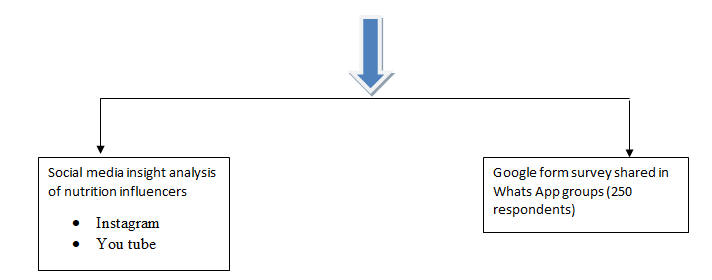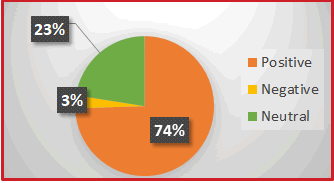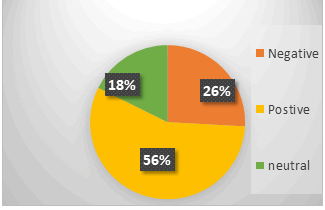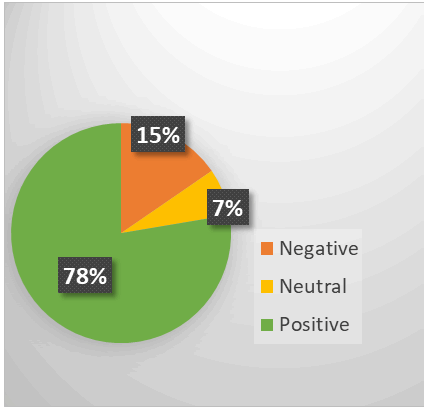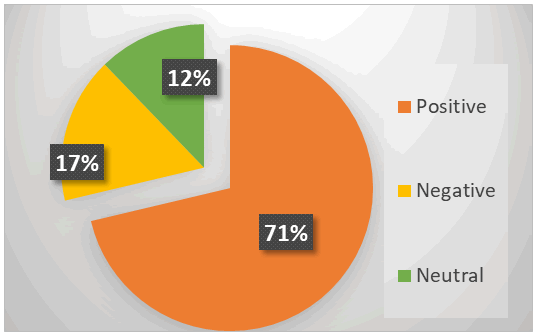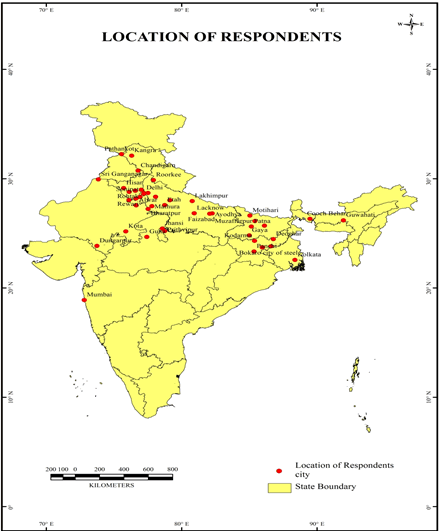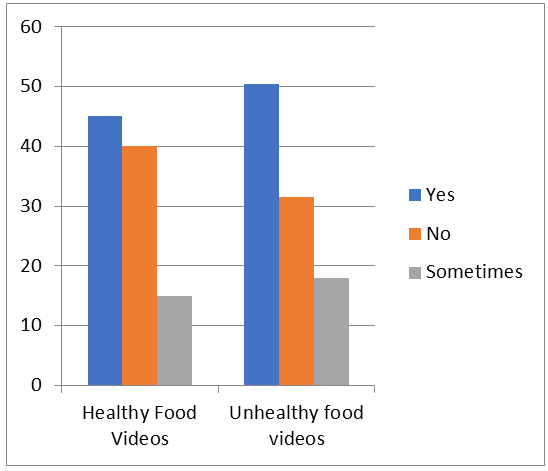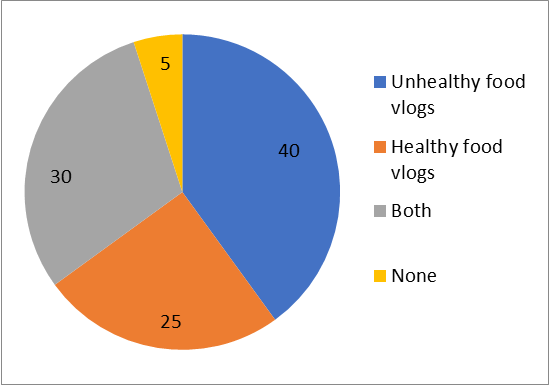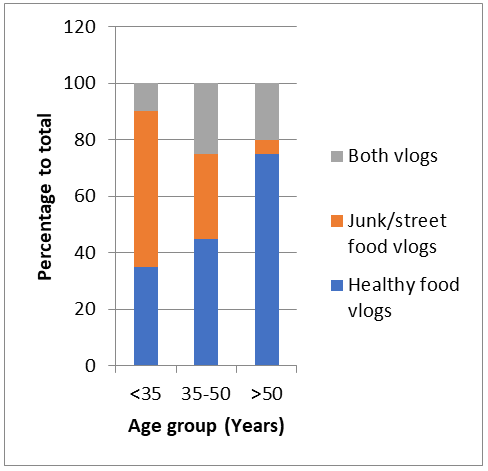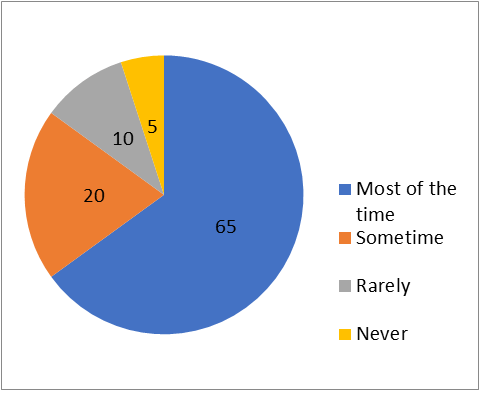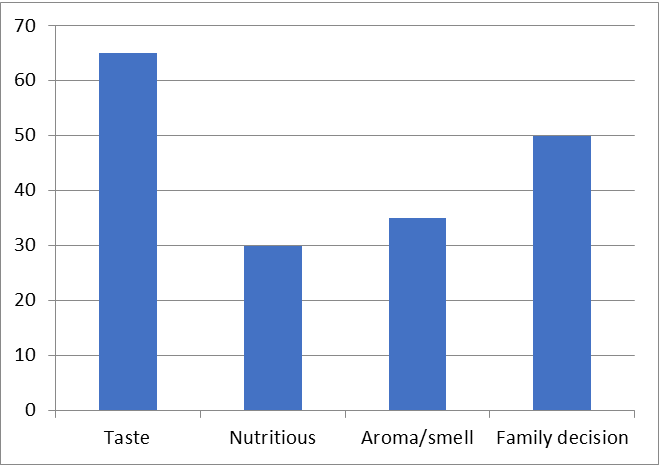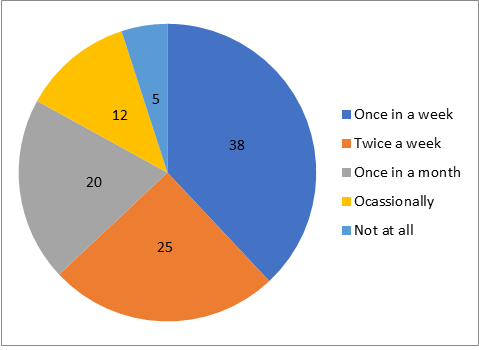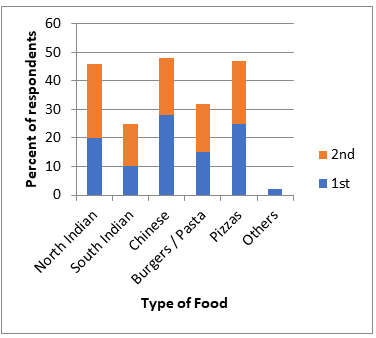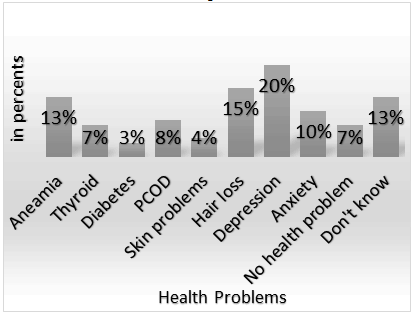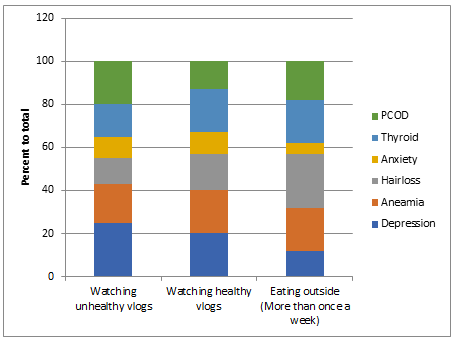Research Article - Journal of Nutrition and Human Health (2021) Volume 5, Issue 10
Virtual gazing, unhealthy vlogs and food choices: A behavioral analysis.
Swati Rajput* Poonam Sharma
Department of Geography, University of Delhi, Delhi, India
Corresponding Author:
- Swati Rajput
Department of Geography, University of Delhi, Delhi, India
E-mail: Swatirajput19.sr@gmail.com
Accepted Date: 20 September, 2021
Citation: Swati Rajput, Poonam Sharma. Virtual gazing, unhealthy vlogs and food choices: A behavioural analysis. J Nutr Hum Health 2021;5(9):1-7.
Abstract
Social media has become a powerful tool to influence human psychology and behaviour. Virtual gazing is becoming a habit. People gaze at varied social media sites for hours. Food which is the basic human necessity has become fancy product to be featured on various social media sites. Society today faces a problem of nutrition paradox i.e coexistence of malnourished and overweight people. Social media through vlogs of influencer (vloggers) promotes different type of junk as well as street food. The vlogs are so powerful that they impact minds of children and teenagers, to an extent that they eat frequently outside their house and land up eating oily and unhealthy stuff. There are vlogs of healthy food influencers too. They are dieticians, doctors or fitness experts. These healthy and unhealthy food vloggers have their own viewers and followers. This paper tries to examine the impact of both the kind of videos on the viewers through social media analysis. Two social media platforms have been selected for this Youtube and Instagram. To assess the impact on these two platforms, influencers of healthy food and street food have been selected and finally sentiment analysis has been done. The impact is also assessed through Google form analysis to understand the food choices and behaviour of people. The correlation is ascertained between unhealthy food vlog watchers, eating outside home, Body Mass Index and hours spend on social media. The paper finds high positive correlation among all the variables
Keywords:
Social media, You tube, Instagram, Vlog, Sentiment analysis, Junk food, Healthy food.
Introduction
Nutrition paradox has become a reality in the world today. This means there is co- existence of undernourished and overweight people. People who consume less than the required nutrients and under nourished people. They are usually poor and under privileged. These people suffer from deficiency diseases. People who are overweight are generally people who consume more carbohydrates, sugar, salt and oil. These people are not very active in their general routine. The prevalence of child under nutrition was 60% in 1990 which came to 40% in 2011. India still continues to have a larger share of stunted, underweight, and wasted children. The underweight rate was about 52% in 1992 and declined to 47% in 1998 and remained nearly almost same (46%) in 2005-2006. On the other hand, over nutrition is also becoming a major public health problem over the past several decades. Studies have shown an increase in overweight children and adults over the past 2 decades especially. In the debate about the childhood obesity crisis, food marketing in media is often named as one of the main causes for children’s unhealthy dietary behaviors. This influencer marketing technique involves the promotion and selling of products or services through social media personalities (“influencers”) who have the capacity to affect the character of a brand. As is the case with food marketing in more traditional media, social media influencers predominantly promote drinks and foods that are high in sugar, fat, and salt. Consumption of these unhealthy products increases the risk of overweight, obesity, and non-communicable diseases.
Healthy food vlogs are the vlogs that have content related to nutritious and indigenous food. These vlogs talk about food ingredients and the methods of cooking. They also discuss benefits of such ingredients and sometimes break our myths about them.
.Unhealthy food vlogs on the other hand talk about food that is high in calories, oil, and sugar or salt. Such unhealthy food creates health issues. Worse in them are the food challenges. Such food challenges are carried out mostly by teenagers that impact their health
The paper aims to analyse the impact of social media on food behaviour and choices. The main objectives are to observe the sentiment analysis of the vlogs of both healthy food and unhealthy food and to understand the food choices and eating behaviour of viewers of such vlogs.
Methodology
To analyse the impact of the food vlogs on viewer, two type of vlogs are selected, i.e, the Indian influencers who promote healthy homemade food and second the influencers who publicises the street or junk food.
- The influencers of healthy blogs are the nutritionists, doctors, fitness experts like Rujuta Diwekar, Pooja Makhija, Ryan Fernando, Abhinav Mahajan, Ranveer Allahbadia Dr. Zubeda Tumbi, Dr. Pallavi, Dr. V.Vijaya Lakshmi
- The influencers of street food/ junk food are SPICE ASMR, The Foodie nation, Aamchi Mumbai, Curly tales.
The videos are selected on the basis of views. The videos that have receives highest views have been shortlisted and out of that one video each is selected. The social media platforms used in this case are You Tube and Instagram as there are 265 million active users every month in India and According to Defy Media, 96% of teenagers between the ages of 13 and 24 uses You Tube on a regular basis for an average of 11 hours a week. Instagram is the most trending social media app, with more than one billion active users. Instagram is very popular among the younger generation in the age group less than 35 years.
The sentiment analysis has been conducted on the selected videos. Sentiment analysis is also called opinion mining. Sentiment analysis helps to understand viewers’ opinion. The comments on the videos has been categorised as positive i.e those who are liking and praising the videos; negative ie who are not liking or giving demotivating comments and neutral i.e the ones who are writing neither positive nor negative or are not talking content basis. It is done for both You Tube and Instagram vlogs. Frequency tables are been created and percentages have been calculated to do sentiment analysis.
The questionnaire analysis has been done to understand the views and opinion of respondents on certain questions linked to the food vlogs and impact of social media. The total of 250 respondents is selected on random basis (Figure 1).
Data Analysis
The sentiment analysis of Healthy videos shows that 74 percent of YouTube respondents talk positive about the videos. They like the vlogs and are interested to ask more about them. They are also impressed with the vloggers and their way of depicting the content.
23 per cent of YouTube respondents are not happy with such vlogs and write negative either about their content or the way of representation (Figure 2).
Sentiment analysis of instagram shows that 56 per cent of respondents talk positive about these vlogs. 26 per cent of the respondents talk negative or dislike the healthy food vlogs either because of their content or presentation (Figure 3).
Discussion
Further analysing the sentiment analysis of unhealthy vlogs, it can be seen that 71 percent of respondents of YouTube and 78 per cent respondents of instagram like such vlogs. These vlogs include street food and unhealthy food vlog challenges (Figure 4, Figure 5).
The analysis shows that both types of videos are equally popular. They have their own set of respondents and own area of influence. The food challenges are other important type of videos which are becoming popular and are viewed by the people especially the teenagers. There are noodle eating challenge, magi eating challenge, golgappa challenge, pizza challenge and many more. Such challenges influence youth’s mind and they try to imitate such challenges. Such challenges are commonly taken up in birthday parties or get togethers. This can take major health tolls.
The study has been carried out during the pandemic situation. Therefore, google form was being made to circulate and aquire peoples responses on various questions linked to healthy/ unhealthy vlogs. The questions were mostly linked to habit of watching such vlogs and eating choices. To find out the repercussion of vlog watching on the health and food choices of people, the google form analysis has been done. The total of 250 respondents answered the questions. The responses have been received from various cities of India like New Delhi, Mumbai, Ghaziabad, Hisar, Bokaro, Mathura, Rewari, Gaya, Patna, Etah, Lucknow etc (Figure 6).
Out of total respondents 58 percent are females and rest are males. Almost 74 per cent respondents belong to less than 35 years of age and 20 percent are between 35- 50 years of age. Remaining around 6 per cent are above 50 years of age.
The data shows that 40 percent of respondents watch junk food or street food videos. Healthy food videos are watched always by 25 per cent of respondents while 30 per cent watch sometimes. This shows that unhealthy food vlogs are more popular among the respondents (Figure 7, Figure 8).
The data figure 8 shows that around 78 per cent of the respondents who preferred to watch healthy food videos are above 50 years of age. This can be because of the reason that they become more health conscious with age. Most of the junk and street food videos are watched by respondents less than 35 years of age (Figure 9).
Further its important to analyse the impact of watching food videos. It was Apicius, the 1st Century Roman gourmand, who purportedly coined the phrase “We eat first with our eyes”. Nowadays, a growing body of evidence from the cognitive neurosciences is revealing just how true this aphorism really is indeed, laboratory studies have shown that watching food-related TV programs can affect people’s patterns of energy intake from a given set of available foods. In fact it would not be wrong to say the mouth waters when eyes eat. The message moves from eyes to stomach. People feel like eating the same kind of food that they watch especially if it looks delicious.
The respondents also replied in the similar pattern as 65 per cent of respondents most of the time feel like eating street food shown in the videos while 20 per cent sometimes feel like eating street food after watching the videos. Around 10 percent rarely feel and 5 percent never feel like eating junk food on watching vlogs (Figure 10).
The data also shows that 25 per cent of respondents try to put the ingredient or cook the ways they learn from the healthy vlogs, while 45 per cent who watch healthy vlog videos are unable to follow due to the taste. The respondents also make the food choices based on certain parameters. The most popular parameter among all is taste. Ancestral feeding behaviour was retained by contemporary humans, although food choices do not pertain to life or death. Nevertheless, taste is still a critical determinant of food selection, especially in children. Similarly, not only in children, the study shows that it is popular among all ages. Around 65 percent gave preference to taste followed by family decision or choice of food. One finds, typically in Indian families, the home cook food is generally prepared by assessing the family choice. In joint family system more than two dishes can be cooked but choice of family members, especially the elderly men are given utmost importance (Figure 11).
The figure 11 shows that nutrition is least important while making food choices. People who go outside to eat give taste to be most important. They infact choose the outlet based on the type of food they want to eat.
While it might seem that the influence of this ‘digital grazing’ is gaining traction across a wide cross-section of the public, there is a very real concern that this onslaught of appetizing food images may be having a deleterious impact on certain of our eating behaviours. It would seem that ‘visual hunger’ may well activate those behaviours that are associated with food consumption in a manner that is relatively automatic.
Eating outside home food has become fashion. Around 38 per cent of respondents eat outside twice a week and 25 per cent of respondents eat once a week. 20 per cent of respondent eat outside once a month (Figure 12).
Food consumed when eating out is usually high in energy content,a factor that may contribute significantly to an excessive energy intake, thereby potentially contributed to obesity. The food cooked and served out side home mostly does not follow health and hygiene norms so it becomes harmful to consume such foods.
According to Hindu Business Line News, The food service segment is estimated to be USD 48 Bn growing at 10%. As per Economic Times 2017, Less time to prepare food at home, increasingly affordability and disposable income has led to growth of Quick Service Restaurants (QSR) and casual dining at CAGR of 22% between 2013 and 2016 (Figure 13).
Figure 13 shows that most of the people gave first preference to eating Chinese food like noodles, momos etc. This is followed by Pizzas. Since most of the respondents are from north India, the preference for South Indian food is low. Junk foods contain high amount of calories, hydrogenated fats and sodium making them one of the major causes of obesity. Not to miss, according to an estimate, one large pizza contains 311 calories, one chicken burger has 360 calories, one bowl of noodles has 490 calories a nd 1 chicken momo has 40 calories. These foods are also high in saturated fats, sodium and cholesterol. Excessive consumption of such food leads to various health challenges like diabetes, skin and hair problem, nutrition imbalance etc. This food, if consumed regularly, can cause deformities in physical and mental growth.
The common health issues highlighted by the respondents show that 20 percent of respondents feel depressed and 10 percent feel anxiety issues. Hairloss issues, anaemia and PCOD (Polycystic ovaries Disease) are some of the common health challenges people are facing (Figure 14).
The respondents watching unhealthy vlogs and eating outside home (more than once a week) have higher rate of depression, anaemia and PCOD as compare to people watching healthy videos. People who frequently eat outside home also have higher rate of anaemia , hairloss and PCOD Figure 15).
Body Mass Index (BMI) of the respondents also depicts that 45 per cent of the respondents have BMI above 25 and 40 percent have between 18-25. Around 15 per cent of respondents are below 18 i.e they are underweight (Table 1).
Table 1. Correlation matrix.
| Hours spend on social media | Watch Unhealthy food Vlogs | Eat Outside Home | High BMI | |
|---|---|---|---|---|
| Hours spend on social media | 1 | |||
| Watch Unhealthy food Vlogs | 0.98432 | 1 | ||
| Eat Outside Home | 0.7746 | 0.83683 | 1 | |
| High BMI | 0.50416 | 0.64842 | 0.77484 | 1 |
The correlation matrix table 1 shows that there is a high positive relationship between Hours spends on social media and watching unhealthy food vlogs. High positive relationship also exists between High Body Mass Index and Eating outside. The correlation matrix clearly depicts more hours watching unhealthy food vlogs more eating outside food and more BMI.
Conclusion
Over 168 Mn social media users in India discuss and share ideas for multiple topics including reviews, suggestions, ratings, etc. on social media platforms. Social media websites and apps like Facebook, Twitter, Instagram, Snapchat, Pinterest, etc. are used to read and write reviews, find new places, find new brands of foods and experiment with new cuisines. An industry study suggested that almost 45% of restaurant-goers below the age of 28 years seek at least some review of the restaurant before visiting. More and more consumers are connecting with each other on apps like Zomato, Yelp, etc. TV viewing and other screen-based behavior shave been linked with an increased consumption of energy-dense and junk foods, of sugar-sweetened beverages, and negatively associated with fruit and vegetable intake, Many more studies focus on the fact that spending higher time on social media influence eating habits and food choices of people.
Self -help
It’s important that we must monitor what we see and hear. Moreover self-control is also an important way of managing health. Promotion of effective community participation and self-reliance of individuals for informed decision making for health are among the basic tenets of primary health care. People need to be self-conscious about their body requirements and health challenges. Food is not just about taste. Rather its about nutrition and sustainability of human body. So, its important that we eat healthy food and exercise regularly to keep our body fit.
Regulations on vlogs
Social Media is almost a free platform to upload anything and everything. But this platform needs to be regulated. Social Media companies should employ compliance officers or vigilance team. It should be mandatory for the vlogs promoting or advertising any unhealthy or junk food to give calorie, unsaturated oil, sodium and sugar content of the food they are promoting. They should also mention in one line the hazardrous health impacts of such foods. Food Safety and Standard Authority of India (FSSAI) should monitor all such vlogs that promote unhealthy junk food and lay down criteria for nutrition claims. Imposition of fat tax for unhealthy food promotion and subsidies on healthy food items should also be done.
Teenagers and children should not promote unhealthy food vlogs
Many children and teenagers do vlogs linked to unhealthy food or unhealthy food challenges. These vlogs become very impactful and gets million of vies and comments. This too needs a regulation on its part as such vlogs tend to motivate the peers and viewers to eat junk food. Recently, Committee of Advertising Practices of Europe, online ads for food and drinks high in fat, salt and sugar aimed at children are banned under new rules from advertisers, More over in 2007 restricted the advertising of junk food during children’s TV Program.
WHO in May 2016, warned that governments should be protecting children from targeted junk food advertisement in apps, social media and video blogs.
In India, 2019, The food regulators have come up with draft regulating proposing a ban on sale as well advertisement and promotion of unhealthy food- High in Fat, Salt and Sugar. This includes discouraging availability of French fries, samosa, pizza, noodles, burgers ETC in and around school premises. But nothing much is done on social media platforms.
Nutrition literacy: Nutrition literacy is defined as, “the degree to which individuals have the capacity to obtain, process, and understand nutrition information and skills needed in order to make appropriate nutrition decisions”. Nutrition literacy needs to be part of school curriculum from primary education. It should be treated as a special subject as it helps students to learn facts about food, nutrition, health and fitness. The healthy vlogs should be promoted by schools and educational institutes. Food discipline and concept of wellness needs to be induced among children and teenagers.
A holistic understanding of healthy and unhealthy food should be imparted to people. Health is an essential component of Development so just for economic gains and media popularity unhealthy food vlogs or unhealthy food challenges should be barred to be promoted. Strict regulations should be imposed on such vloggers if they do not follow the norms while promoting the unhealthy junk food.
Acknowledgement
Research team: Astha Gupta, Deeksha Devi, Medha Yadav, Ritu Kumari and Rohit Modi, Department of Geography, Shaheed Bhagat Singh College, University of Delhi
Conflict of Interest
None
References
- Vehling JD, editor. Cookery and dining in imperial Rome. Courier Corporation; 2012 May 7.
- Barr-Anderson DJ, Larson NI, Nelson MC, et sl. Does television viewing predict dietary intake five years later in high school students and young adults?. Int J Behav Nutr Phys Act. 2009;6:1-8.
- Borraccino A, Lemma P, Berchialla P, et al. Unhealthy food consumption in adolescence: role of sedentary behaviours and modifiers in 11-, 13-and 15-year-old Italians. European J Pub Health. 2016;26:650-6.
- Boyland EJ, Nolan S, Kelly B, et al. Advertising as a cue to consume: a systematic review and meta-analysis of the effects of acute exposure to unhealthy food and nonalcoholic beverage advertising on intake in children and adults, 2. American J Clinical Nutr. 2016 ;103:519-33.
- Ouwehand C, Papies EK. Eat it or beat it. The differential effects of food temptations on overweight and normal-weight restrained eaters. Appetite. 2010;55:56-60.
- Spence C, Okajima K, Cheok AD, et al. Eating with our eyes: From visual hunger to digital satiation. Brain Cognition. 2016;110:53-63.
- Coates AE, Hardman CA, Halford JC, Christiansen P, Boyland EJ. Food and beverage cues featured in YouTube videos of social media influencers popular with children: An exploratory study. Front Psychol. 2019;10:2142.
